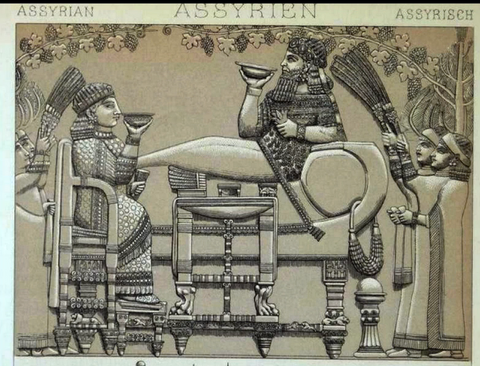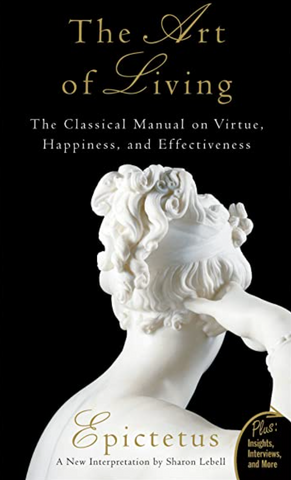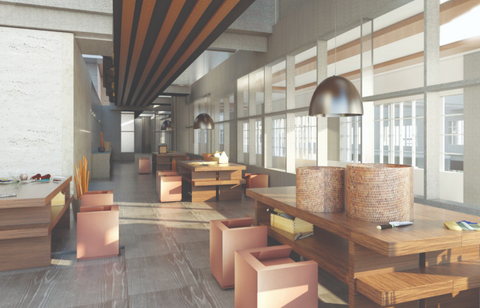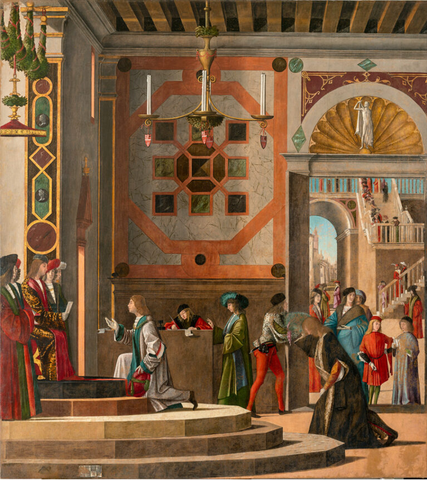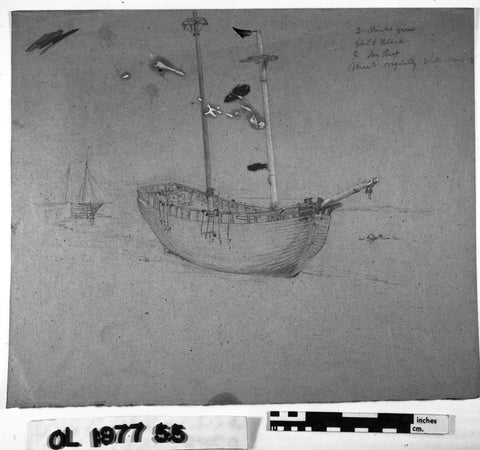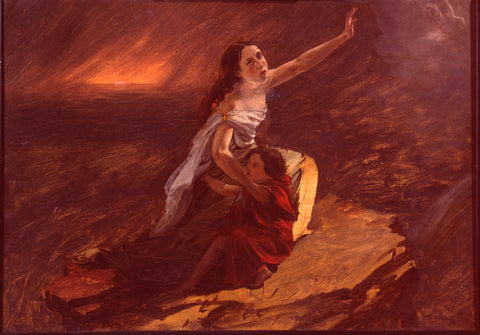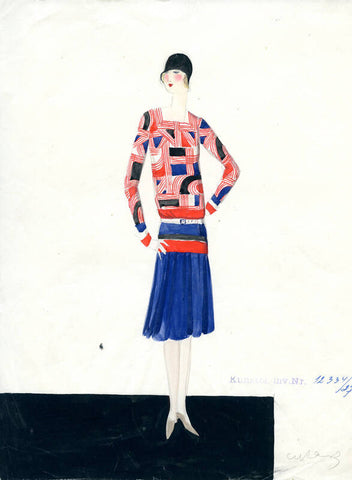Frick Collection: Mechanical Table by Martin Carlin
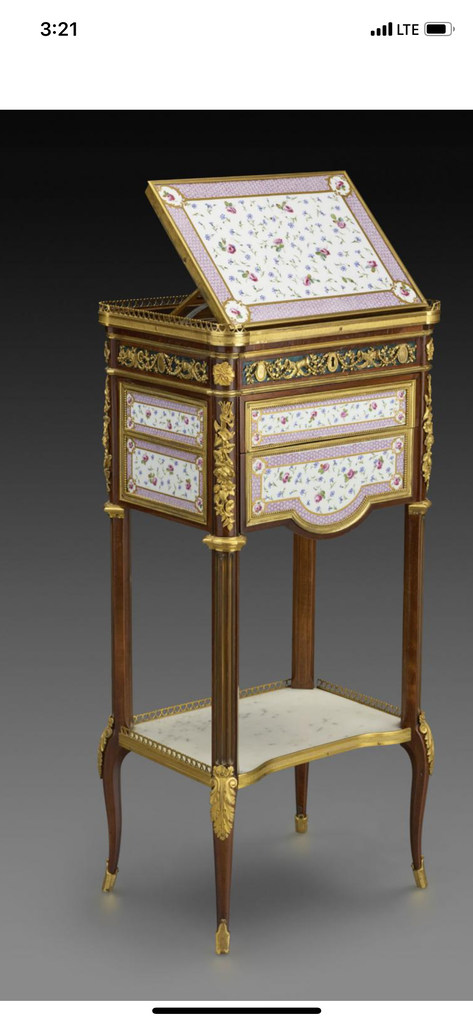
Frick Collection: Mechanical Table by Martin Carlin, accession # 1915.5.62, Boucher Room
The Mechanical Table built by Martin Carlin, a German-born cabinet maker who worked in Paris, was constructed around 1780 out of oak veneered with maple, plaques of porcelain, and gilt bronze, in the French 18th Century Neo Classical style.
This small rectangular side table is just over a foot wide and under a foot deep, and about 4 feet high. The table is constructed mostly of wood, with porcelain inlays on the top and sides, gilt bronze decoration, and a marble lower shelf which sits in between the four legs about a foot off the floor, or a third of the way up from the ground to the table base. The table legs sit on the floor with each foot protected by a gilded cap and rise to the horizontal shelf where they meet the four corners in a cabriole shape, and then continue straight up to meet the porcelain inlaid table form. The knees of these shortened cabriole legs (the legs from the bottom shelf to the floor) are gilded with acanthus leaf style ornamentation, which ends in a swirling ionic column type of decoration at the level of the shelf. The shelf itself is made of marble, with a filigree of gilded bronze heart shaped ornaments surrounding the shelf like a perimeter fence. The same filigree border protects the shelf on the top of the table as well.
The delicate legs continue up to the body of the side table, where dual panels are inlaid on each side in Sevres porcelain with a white background and pink rose flowers with light blue flowers in the background. The sides of the mechanical piece and main part of the table are decorated with gilt bronze flower garlands, which separate the four pairs (two panels on each of four sides) of Sevres porcelain panels. The garlands are very intricate (see detailed on site drawing below), representing tied bundles of flowers falling downward. The flowers include a rose and bluebonnets. The top of the table lifts up several inches higher and wooden panels extend, possibly to hold candles for lighting at night. The mechanical instrumentation is quite difficult to work, thus indicating that the form of the piece was meant to be used more for entertainment than for a purpose.[1]
This table is illustrative of the period in France for three main reasons. First, the piece itself it is indicative of a very popular style of small side table. This became a prevalent piece of furniture because of how people were spending their time in this era. Leisure activities like sitting, talking and playing games required more occasional tables on which to put things around the room for lighting (candlesticks) at night, for teacups, or to rest a hand of cards.
Secondly, the style of the table is decidedly 18th century transitional (from the Rococo to the Neoclassical style) in the latter part of the century. It has the delicate look and light graceful legs with the small cabriole knees typical of furniture in this time. The mid-18th century in France was characterized by a playfulness and lighthearted gaiety under Louis XV and was manifested in the lighter scale and pastel colors of the Rococo (versus the previous Baroque style). The furniture often had more exposed wood, gilding or painting. The wealth of the Louis XV French court, especially during the building of Versailles, created new industries around crafts and expert craftsmen became famous, including the maker of this piece.
Along with carving and gilding, Sevres porcelain became popular with the wealthy in France. In the 18th century France discovered how to manufacture porcelain, and Sevres was the finest maker under royal domain. The porcelain often included a white ground with fields of color and decoration with little flowers in the pastels, representative of the textile patterns popular at the time. As Louis XVI came to power in 1774, Neoclassical design was fully formed, which often included other materials in the furniture forms, such as inlaying Sevres painted plaques into this wooden piece. Also, the cabriole legs are slightly straighter and less prominent that earlier styles, and the marquetry includes floral elements. Martin Carlin who worked in this period and designed this desk specialized in Sevres porcelain plaques, and his tables are distinct for these inlays into sides or tops of tables. The geometric forms of Carlin’s table are classical, and the feet are simple like the tip of a sword, placing it as Neoclassical.
Lastly, the function of the table locates it as a late 18th century transitional Neoclassical piece. The furniture was meant to inspire amazement and joy, not just in the decorations, gilding, carving and detailed ornamentation, but the very use itself was meant to be spectacular. This can be seen in the fascination with mechanical furniture, which arose in the mid to late 18th century. Pieces of furniture became quite fantastic: doors would open out on either side, and then further expose other hidden drawers or doors, sometimes spring loaded to pop open. These extraordinary and amazing pieces relied on mechanical elements for machinery made to amuse the extremely wealthy. These transforming pieces are beautiful but not necessarily useful in their dual functions; they demonstrate the pinnacle of excess before the aristocracy could not sustain itself any longer in France at the end of the 18th century. This time in France, in all its glory, has been compared to a “burst of bright light for the aristocracy before it flashes out”[2] and this piece of furniture exemplifies that style.
Works Cited
Lecture, Freya Van Saun, Historical Styles 501LDL, Module 9, 18th Century France
Carlin, Martin. “Mechanical Table.” – Works – Collections.frick.org, 2019, collections.frick.org/objects/65/mechanical-table.
Drawings: hand drawn sketches by Kate Davis
Hand drawn sketch of the mechanical table, by Kate Davis
Hand drawn sketch of the gilded decoration along the table base, by Kate Davis
Other Images

Hand drawn sketch of the mechanical table, by Kate Davis

Hand drawn sketch of the gilded decoration along the table base, by Kate Davis

Mechanical Table from front and side, Frick Museum Website

Mechanical Table fully open, Frick Museum website
[1] Carlin, Martin. “Mechanical Table.” – Works – Collections.frick.org, 2019, collections.frick.org/objects/65/mechanical-table.
[2] Freya Van Saun, lecture on Louis XVI style furniture

